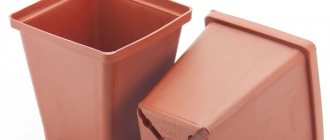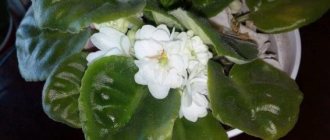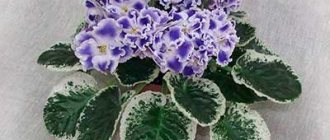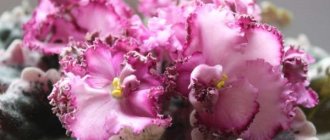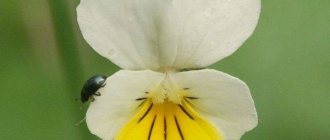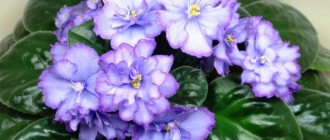Features of Saintpaulia, its appearance
You already know that the birthplace of violets is Africa. Saintpaulia is a perennial plant up to 30 cm high. It has a short stem, large leaves, and an oval shape. Some types of violets have heart-shaped or elongated leaves. The color also differs - from light to dark green.
Visual photos confirm the incredible variety of colors and shapes. You can find a flower with double, corrugated, wavy or fringed petals. The average diameter is 2-4 cm, both single-color and multi-color colors are found. Night violet and Labrador violet, swamp violet and butterfly violet... It seems as if all these varieties are competing with each other in beauty.
Previously, indoor Saintpaulia had no smell and pleased gardeners solely with its appearance. As a result of long and painstaking breeding work, hybrids with a subtle, very pleasant aroma were bred.
Ampel violets: description and characteristics of varieties
Ampelous violets: photo
A distinctive feature of these violets is the form of development. Ampelous violets have elongated hanging shoots, on which many rosettes with peduncles are formed. However, among the varieties of ampelous violets there are those that develop on one shoot growing upward.
Ampelous violets are the result of crossing two types of plants - rosette violets and natural Saintpaulias, which are distinguished by an ampelous structure.
This species was first obtained in the middle of the last century, but Russian flower growers became acquainted with them much later. They owe their appearance to breeder Frank Tinari. By the way, many of their varieties are named after him (Tinaris Sky Blue Trailler, Tinaris Ceneva Trailler, etc.).
Ampelous violets, like rosette types, are available in different sizes. They are ordinary, miniature and semi-miniature, as well as microminiature, in which the size of the leaf plate does not exceed 1.2 cm. It should be noted that for this type of violet, the classification is based on the size of the leaf.
You can often hear another name for the species in question - trailers, that is, plants with several growth points and elongated hanging stems.
Another reason for the growing popularity of trailing violets is their almost constant flowering. Indeed, unlike ordinary violets, ampelous species develop significantly more rosettes and peduncles, and, therefore, they bloom more luxuriantly and for a longer period of time. Entire hanging gardens are created from violets of this type, which are absolutely stunning spectacles.
The most extraordinary story about the origin of Saintpaulia
One of the main questions of our article is as follows: when and under what circumstances was the plant discovered? Baron Walter von Saint-Paul, who was the governor of an African state, knew exactly what a violet looked like. While exploring the Ulugur and Uzambara mountains, the researcher met a flower that captivated him with its beauty. The sky-blue radiance surprised Saint-Paul so much that he immediately wrote up a description of it and sent it to his father, a well-known orchid collector at that time.
We also recommend reading
- Beautiful yard of a private house with your own hands: everything about arranging the yard
- Rose park
At first, the night violet was “enlisted in the ranks” of the Gesneriaceae family.
The official year of birth of the flower was 1893, when the plant was described in detail and officially presented at an international exhibition.
Having earned recognition, the violet, whose homeland was the African continent, almost instantly adorned window sills in most countries of the world.
Professional gardeners - about the nuances of care
Planting and care have their own specifics. The plant does not like cold and reacts to it very quickly. Humidity and light are a completely different matter. But here it is important not to overdo it. For a plant such as violet, almost all species need shade if it is a hot and sunny day outside. The duration of daylight hours should be 13-14 hours.
Violet is an amazing, delicate “beauty” among other flowers. Gardeners love marsh violet, butterfly violet and some other varieties for their prolific flowering (sometimes up to 9 months). So that you can observe beautiful flowering for as long as possible, planting and care should also include sufficient lighting. To do this, creeping violet and night violet are placed on window sills that face west, east or north. Windows on the south side are also suitable, but it is advisable to place the pots on a table or shelf at the back of the room or to the side of the window.
As for temperature, the range from +18 to +24 is considered optimal. In violets, growth and reproduction deteriorate when there are changes in cold and heat in the apartment.
Pansies are rarely found in apartments and private houses (violet does not grow well in greenhouse conditions), as well as marsh violet. Preference is given to hanging varieties. They are distinguished by rather voluminous rosettes, stems falling down.
Ampelous violets: varieties with names
Ampelous violet Robs Vanilla trail: photo of the variety
Breeders from many countries are working on developing new plants. To date, the number of ampel varieties has already exceeded five hundred. Below we give examples of several varieties classified by gardeners as among the most decorative.
- The ampelous violet variety “Lituanika” is the result of the work of Lithuanian breeders. This plant is distinguished by its highly dense inflorescences and slightly elongated leaf blades. The flowers have a soft pink color with a barely noticeable peach tint. In combination with dark green leaves, a rosette of blooming violet looks very elegant. Another reason for the popularity of this violet is its abundant and long-lasting flowering. The plant received its name in memory of two American pilots of Lithuanian origin who attempted to fly from the capital of Lithuania to New York in 1933. Lituanik's plane successfully crossed the Atlantic Ocean, but never reached its destination, crashing under unclear circumstances.
- The next variety of ampelous violet is “Robs Vanilla Trail”. This violet is one of the semi-miniature trailers, the size of the leaf plate of which is 2.4-3.8 cm. The name of the variety corresponds to the color of the flowers, which have a slightly creamy, milky tint. The flowers are double, and the foliage is very prominent with a jagged edge. This variety was bred by American breeder Ralph Robinson. By the way, all the varieties he received have the prefix Robˊs.
- The Milky Way Trail variety is also a representative of semi-miniature plants. The flowers are semi-double, very small in size, white in color, which harmoniously combines with the green leaves. Flowering is abundant and long lasting.
- “Dancing Trail” ampelous violet is distinguished by rather long peduncles, which, over time, form a real cascade. The flowers are double, red-crimson in color. The leaves are rich green with a slight sheen. The shape of the leaf plates is slightly elongated with a pointed edge.
- “Trail Along” variety is one of the miniature violets, with a leaf blade up to 2.5 cm. Many elongated drooping peduncles are decorated with soft pink flowers. Double inflorescences with deeply separated petals give the plant a special decorative appearance. The flowering of violets of this variety seems endless.
- The ampelous violet "Rondita" is a semi-miniature trailer. The shape of the flowers resembles the opened buds of very small roses. Flowers that have just bloomed have a soft pink color, while those that have already faded have a barely noticeable pink tint. The leaf blades are round, with a pointed edge, and look like hearts. Violet blooms very profusely, but not for long, since the variety is industrial. That is, after a certain time, flowering ends and the plant will not bloom again. Attempts to propagate this variety are useless.
Soil preparation for Saintpaulia and watering features
Perennial violet is planted in plastic pots with a diameter of 5 to 9 cm. Due to the root system of a superficial type, it is recommended to give preference to flat pots. Loose soil that absorbs water well and allows air to pass through is suitable. The store sells a ready-made base, although you can prepare it yourself. In order for the horned chrysalis violet and the Rococo variety to grow well, it must consist of 2 parts of humus and 2 parts of turf soil, 4 parts of half-rotten foliage, pine soil, sand and charcoal (1 part each). A bucket of this mixture is mixed with half a glass of ash and superphosphate (2 tablespoons).
Be sure to run hot water over the pot before filling it with soil. This will destroy harmful microbes.
In order for the night violet to bloom profusely, as in the photo, it needs to be periodically fed with fertilizers. You can mix them directly into the soil or dilute them with water for complex watering. In the second case, the concentration decreases by 6-7 times. This will prevent the plant from burning.
Also make sure that the vetch and garden violet are not covered with white dust. This deprives the flower of its aesthetics and prevents it from developing and breathing normally.
To prevent white dust from appearing, night violet and viola are watered with warm water twice a month. It is advisable to immediately cover the soil with paper or polyethylene. It is recommended to carry out water procedures in the evening or early in the morning. The plant will be able to dry out before the first rays of the sun touch it.
For watering, use tap water, previously brought to a boil and cooled.
How do plants reproduce?
Care and propagation vary depending on the specific variety. For the horned violet species, growing from seeds will be most relevant; the rest are best propagated using leaves and cuttings.
In the first case, you need to carefully examine the leaves. If you see thrips on violets, the leaves are definitely not suitable - look for exclusively healthy parts. Carefully cut the leaf and place it in a container with a nutrient substrate. Then place in a plastic bag and close tightly. An artificially created greenhouse effect will provide the plant with the required amount of moisture. Water the leaf from time to time, but do not allow it to become over-watered. As soon as new leaves begin to appear, the bag is removed. This will allow the plant to grow and develop independently.
And there is a second, simpler method of propagation by leaves. Find a good, healthy leaf, like in the photo, place it in a glass of water and wait for roots to form. As soon as they reach a length of 1 cm, the plant is planted in a pot.
You may have probably seen in photos or other articles that seeds are used to propagate flowers. It is worth noting that this method is quite complex, because the seeds need to be collected, the necessary conditions for growth must be created, planted and replanted correctly. Therefore, we recommend that you choose leaf propagation as a simpler and more affordable method.
Traditional medicine: Wiki: Violet
- Violet (1)
- Botanical characteristics of violets (1.1)
- Violet propagation (1.2)
- Violet flowers (1.3)
- Violet Leaf (1.4)
- Violet care (1.5)
- Indoor violet (domestic) (1.6)
- Varieties of violets (1.7)
- Useful properties of violets (1.8)
- Application of violet (1.9)
- Contraindications for the use of violet (1.10)
Botanical characteristics of violets
Violet is a low perennial plant with a creeping, growing rhizome.
The petiole leaves of the violet are heart-shaped. Single flowers come in a variety of shades. The violet fruit is presented in the form of an interesting capsule with a large number of seeds. The root of this plant is thin and poorly branched. The flowering of this herbaceous plant begins in mid-March and ends in May. It bears fruit in August. Violet can be seen in parks, forests, between bushes and under trees. This plant is found throughout Russia. Decorative violets bloom with pleasure in front gardens and flower beds.
Violet propagation
Violets can be propagated by seeds, but sometimes the method of cutting shoots is used. From seeds the plant grows much stronger than from cuttings. Seeds need to be planted in beds. Shoots will appear in April. And after a month they need to be transplanted separately from each other. Do you want to see beautiful violets in a pot on your windowsill in winter? To do this, at the end of summer, dig up the plant along with a lump of earth. Plant the finished plant in a pot with fertile soil and place it in a cool place. In winter, move this pot with the plant to a place with 10 degrees of heat.
Violets grow well in light and shade. This plant can grow well under trees. Violet does not tolerate drought. Fertile, loose and slightly moist soil is most suitable for growing violets. Wild violets can be seen in lowlands because moisture accumulates there.
Every 3 years after planting, it is necessary to remove old plants and plant new ones. At the same moment, fertilizers (compost) are added. If the violet does not have enough air or is not watered enough, it will be affected by spider mites.
It is better to sow violet seeds immediately after collection, as they quickly lose their viability. Violet is a plant that can reproduce by self-sowing. It needs to be weeded regularly. Violet is an unpretentious plant. It needs regular watering, loosening and weed removal.
Violet flowers
Violets are fabulously beautiful flowers that delight with their variety of shades and shapes. The size of flowers and leaves varies widely. Thanks to selection, various varieties have been developed - from miniature to incredibly large. The flowers of this elegant plant contain anthocyanin glycosides and essential oil, making it an effective remedy in the treatment of eczema, lichen, urticaria and cracked lips. Fresh flower juice is often used for smallpox and severe coughs.
violet leaf
Violet leaves amaze with their content of beneficial substances. A decoction of these parts of the presented plant in combination with honey can cure chronic pharyngitis, cough and various gastrointestinal ailments. An infusion of violet leaves is useful for soothing watery or irritated eyes.
Violet care
Violet grows well both in sunny places and in partial shade. It prefers clearings under trees. For cultivation, you should choose loose, fertile soil. Due to the fact that violet does not tolerate drought, it should be watered abundantly and regularly. Wild perennial violet can be seen in darkened lowlands, as moisture accumulates there.
How to care for violets at home
. This elegant plant reproduces by seeds. In order for the violet to feel good, it must be weeded often. Every three years, old plants should be removed and new ones should be planted at the same time as fertilizing the soil. Violet loves fresh air and good watering.
Indoor violet (domestic)
Unique indoor plants love high levels of indoor humidity. But do not forget that spraying leaves is strictly prohibited. Caring for violets will not be difficult even for a novice florist. For propagation, you can take leaves from the middle row, which give good offspring. The main thing is that the leaf shape is not too elongated. Place the cutting in water until roots appear.
After this, it can be transplanted into fertile, moist soil. It should also be noted that significant hypothermia of the root system often leads to the death of the flower. This is why the plant should be protected from frost. The ideal place for a pot of violets would be the eastern side with sufficient lighting. The best temperature for proper cultivation is between 20 and 24 degrees.
Varieties of violets
These beautiful flowers come in a huge number of varieties. Graceful violets can be classified according to the type of flower. Small flowers are less than 2 cm in diameter, medium - 2–4 cm, large - up to 6 cm. Depending on the size of the violet bushes, there are simple - rosette up to 8 cm - and practical miniature - from 6 to 8 cm. You can also divide varieties by the number of petals. There are simple types with even leaves, double ones with fluffy leaves and lush flowers, and semi-double ones with wavy petals.
The shape of the violet flower is also important. In classic varieties, the upper petals are larger than the lower ones. The star violet has all the same petals. Narrow buds are found on bluebell violets. If the top two leaves have grown together, then you have a “violet-wasp” variety. In addition, violets can be divided by color - single-color, multi-color and chimera violets. Depending on the original pattern on the leaves, there are varieties of finger, moiré and edged.
Uzambara violet.
This perennial plant has a short, succulent stem on which there is a rosette of leaves. As a rule, the leaves of this variety, heart-shaped at the base, are no more than 8 cm. The flowers of Uzambara violet are collected in small inflorescences. The fruit is presented in the form of a densely pubescent capsule. Modern varieties of this species may differ in the size and shade of the petals.
Blue violet.
The blue violet impresses with its attractive flowers in a heavenly hue. Elegant wavy edges give the flowers a special charm. The leaves are pale green in color and have a serrated edge. Flowering is usually quite abundant. This variety of violet will decorate the collection of any gardener.
White violet.
White violet has densely double large flowers that look great on a compact rosette of dark green leaves. The snow-white shade gives the variety innocence and grace, causing undoubted tenderness. Almost always, white violet has a lush composition of white flowers, which will decorate your interior.
Violet Yang.
Unusual Yang violets are unique varieties that have unusual shapes and sizes, as well as exclusive combinations of shades. These fantastic plants often have indented or wavy edges and light green leaves.
Red violet.
This variety of violet can rightfully be called one of the most common varieties, which every self-respecting gardener has. Such violets have a wide variety of shades - coral, ruby, raspberry, purple, wine and burgundy.
Useful properties of violets
Violet contains all substances and elements useful for the human body. The plant has anti-inflammatory, diuretic, laxative and antimicrobial properties. It is also used as a good pain reliever and sedative. In addition, this plant is often used to lower blood pressure.
Violet herb is used to treat bronchitis, sore throat and whooping cough. Violet decoction helps improve well-being with bronchitis, cough, pneumonia and suffocation.
In addition, violet can treat all kinds of skin diseases. A decoction of the plant will help improve overall well-being after an illness.
Application of violet
Violet is equally used in folk medicine as an excellent internal and external remedy. Violet tea is useful for dry bronchitis; in addition, it perfectly cleanses the blood of harmful substances. This plant is recommended not only for inflammation of the respiratory tract, but also for headaches, migraines and epilepsy. Violet leaves are used for external treatment of the epidermis.
The leaves of the plant are used externally for various skin diseases. An infusion made from the flowers of the plant is indispensable for convulsions, memory loss and tinnitus.
Violet for cough.
The infusion is prepared as follows: take 50 grams of herb and violet flowers and grind them. Pour the mixture with a glass of boiling water. Let it sit for a day. After straining the composition, it is heated over a fire and a glass of sugar is added. You need to take the prepared infusion 4 times a day, 1 teaspoon. The optimal course of treatment is 7 days.
Violet tincture for sore throat.
To prepare it, you need to take 50 grams of violet flowers and pour a glass of alcohol. Let it sit for 1 week. The tincture should be taken three times a day, 30 ml before meals. And after eating before going to bed, you need to gargle with the same tincture: dilute 10 grams of tincture with a glass of warm water.
Violet flowers in milk for insomnia.
Take 3 grams of plant flowers and pour in 200 ml of boiled milk. Let it sit for half an hour. You should drink the finished milk before going to bed and eat the flowers.
Violet for rheumatism and gout.
30 grams of violet herb and roots are poured into 1 liter of boiling water and taken during the day instead of tea.
Violet syrup for coughs in children.
To prepare it, take violet flowers and fill the cup to the top. Next, pour 200 ml of boiling water into it and leave to infuse for 24 hours. After straining the finished broth, squeeze out the raw materials and throw them away. And fresh flowers are again added to the decoction and left to brew for a day. Now, having filtered the infusion, add the same amount of honey as the decoction. Take the medicine 3 times a day, 1 teaspoon.
Violet during pregnancy.
Take 10 grams of violet herb and pour a glass of boiling water. Pour into an enamel bowl and cover tightly with a lid. Place in a water bath for a quarter of an hour, then remove from heat and leave to brew for an hour. After straining the broth, squeeze out the raw materials. You need to add another glass of boiling water to the finished broth. The resulting product is taken three times a day.
Contraindications to the use of violets
Don't forget that violet is a poisonous plant! That is why when taking orally, be careful in dosages.
Taken here
1
Tags: herbalistherbsviolet

